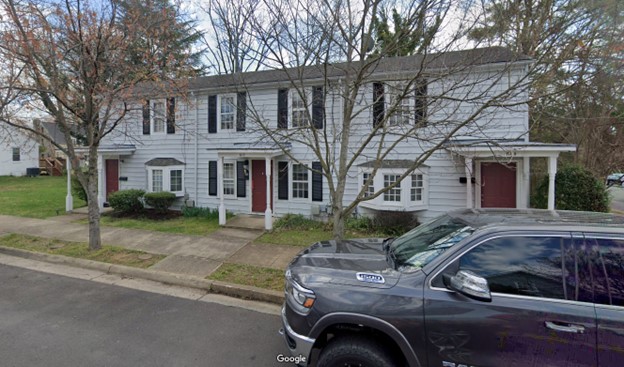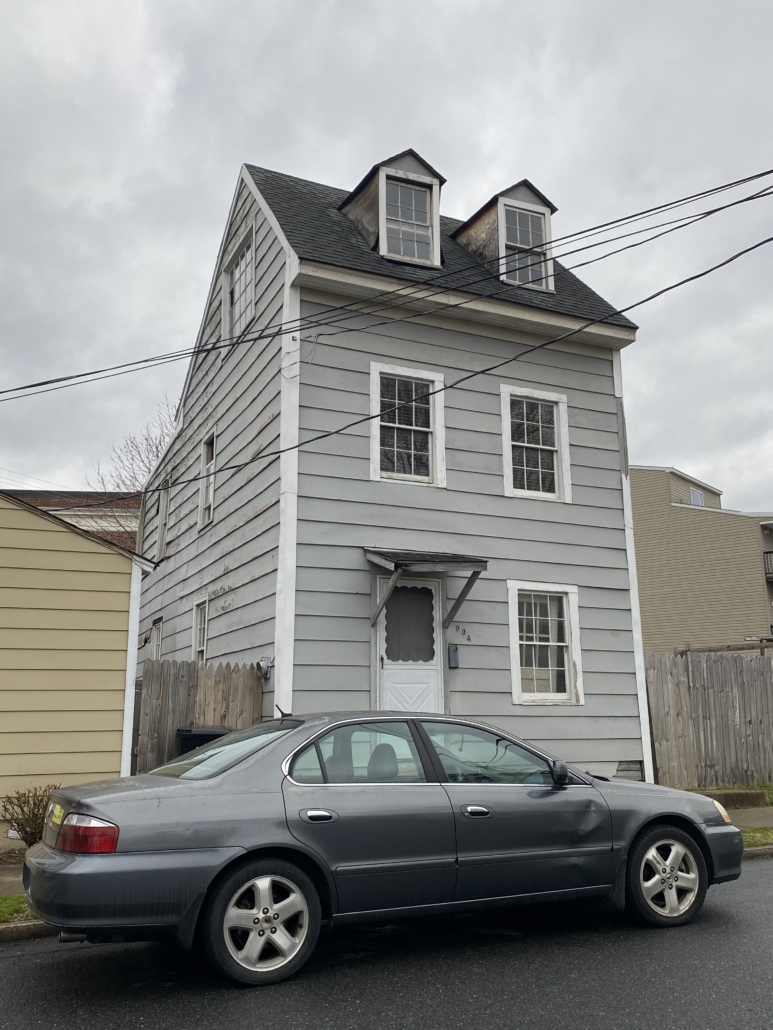Preserving FXBG’s Most Affordable Housing
Written by Danae Peckler, HFFI Preservationist
(A shorter version of this article was published in the June 2025 issue of The Front Porch Magazine, page 19)
It is common sense to most people: the lowest priced homes in the market are smaller, older, and not made for HGTV. We’re talking about that tiny apartment, townhouse rental, two-bedroom cottage, converted basement or that place that needs a lot of work. These quirky old places are referred to as “naturally occurring affordable housing” (NOAH) or “market-rate-affordable” by housing advocates, urban planners, and some real-estate industry professionals.
NOAH comprises 75 percent of an estimated 12 million existing affordable units in America today. This categorization refers to the existing stock of privately-owned, unsubsidized, modest-sized houses and apartments that are rented at rates below the regional average. This type of housing is most vulnerable to market pressures like rising property values and redevelopment trends, which can lead to displacement of long-time residents and a decrease in NOAH.
For decades, those advocating for Historic Preservation and/or Affordable Housing have often partnered in the rehabilitation and adaptive reuse of older buildings to create new housing opportunities–a collaboration supported by both state and federal tax incentives geared towards the reuse of historic buildings and increase in low-income housing opportunities. Similar examples of this type of adaptive reuse work in the City of Fredericksburg includes the conversion of the old G&H factory and Maury School into condominiums and some office space in the 1990s and 2000s. More recent examples include the adaptive re-use of the Janney-Marshall Warehouse on lower Princess Anne Street into apartment units.
The Preservation Compact, a non-profit Community Impact Corporation and policy collaboration thinktank, and the Institute for Housing Studies at DePaul University, have studied NOAH extensively across the country to support its preservation. “Unsubsidized, naturally occurring affordable housing (NOAH) comprises the majority of affordable rental housing, and needs investment. The responsible small businesses that own NOAH need support.” This collaborative effort identified effective NOAH preservation strategies based on market conditions.
In lower cost markets, the vast majority of NOAH is owned by competent, responsible private market owners. In these neighborhoods it is likely that small and mid-sized for-profit owners can efficiently preserve affordability, but they are typically not looped in to government and industry policy discussions, and may need support.
In markets where values are rising, NOAH is lost over time as prices and rents increase. Mission driven developers play a critical role in these neighborhoods to keep NOAH affordable over the long term. Those developers need tools and effective strategies in strengthening markets…
Increasingly stressed by rising market values, Fredericksburg’s NOAH seems to be in a period of significant transition. So what do we know about this important sector of our housing stock? Last month, City Planning Commission and staff discussed “tracking housing production” with City Councilors without mention of any plan to monitor our existing housing stock or identify what NOAH the city may have lost in recent years (see points made at joint meeting of City Council & Planning Commission on Comp Plan revisions: 2025.4.9_PC_CompPlan_comments-from-PC-CC-joint-mtg).
How do we know if FXBG is growing or losing its most affordable housing? Who are the competent and responsible private owners and mission-driven developers that steward our NOAH? Do you know any of these kind of developers? Are they included or involved in local affordable housing groups? What can we do to further support the preservation of our City’s older and smaller homes?

A circa-1930s triplex on Maury Street. This kind of NOAH might benefit greatly from an increase in the City’s Rehabilitation Tax “Credit” (or relief) program, designed to support safely updating and improving older buildings in town. State law provides quite a bit of room for the program’s expansion.
HFFI is proud to know one such competent and responsible private owner – the president of our organization, David James. James has been one of the City’s competent, responsible, small-scale landlords for more than 20 years, maintaining nine affordable units that rent from $600 to $1,050 a month. A self-taught handyman, David does the basic maintenance and repair work for his properties. He hasn’t raised the rent for more than a decade, and he knows his tenants fairly well. Recalling their names and occupations with ease: a plumber, retired railroad engineer, safety contractor, bartender, pizza chef, convenience store clerk, nurse, civilian in food service at Quantico, and bookmobile driver.
“The greatest threat to affordable housing is not the lack of resources to build, but the lack of resources to operate, maintain, and repair,” says Priya Jayachandran of the National Housing Trust in her op-ed, “In the Rush to Build, Existing Affordable Housing Is Falling Apart,” online at Shelterforce.org.
The benefits of preserving affordable housing are clear and compelling. First and foremost, only by preserving existing housing at the same time as we build new housing will we move the needle on our supply shortage; building new units while hemorrhaging existing stock is treading water at best and losing ground at worst.
Preserving housing is much less expensive than building new…. Preservation leverages prior investments in affordability by extending the life of homes we’ve already created. It’s also faster—an affordable home that is renovated and preserved can be available to families in need of housing in a fraction of the time it takes to build new housing.
Preservation uses less energy and carbon than building new. And most importantly, preserving existing housing averts displacement of residents and addresses housing stability as well as supply.

Prior to its June 2025 demolition, this 1890s dwelling on Liberty Street sold in November 2022 for $100k less than what the owner is hoping to get from the vacant lot now that the property is back on the market in July 2025. A slew of unresolved maintenance code violations were able to go unaddressed in recent years.
Want to learn more about FXBG’s efforts to Preserve NOAH and safely rehabilitate our existing building stock?
HFFI Op-Ed: Most Affordable Housing Isn’t New
2025-2029 City of Fredericksburg’s Community Block Development Grant Action Plan
- “Fredericksburg has limited issues with substandard housing. 2016-2020 CHAS
data reveals that 105 low to moderate-income renters reside in housing lacking complete plumbing and
kitchen facilities. This indicates there is some need for quality rental housing and rental property
maintenance” (p. 24). - “A declining level of homeownership in Fredericksburg has been a concerning housing trend for several
decades. Homeownership levels during preceding decades were 37.3 percent in 1970, 40.9 percent in
1980, 50.9 percent in 1990, 36 percent in 2000, and 38 percent in 2010. The 2020 ACS identifies a 39
percent homeownership rate” (p. 50). - “According to the 2018 City-wide market analysis, there are approximately 12,000 housing structures in
Fredericksburg. This inventory includes a mix of 45% multifamily units, 40% single-family detached
homes, and 15% townhomes/attached units” (p. 50). - “Exterior condition surveys of City neighborhoods have identified several general areas with a
concentration of housing units in need of repair. Conditions requiring attention are defined as those that
are detrimental to the household’s health and safety, including but not limited to leaking roofs,
inadequate electrical service, and inadequate or failing plumbing. The real estate market has often
resulted in the renovation of many substandard units, but there are still pockets of substandard
dwellings throughout Fredericksburg” (p. 60). - “The age and condition of the local housing stock have also been a factor in developing CDBG programs.
27% of Fredericksburg’s housing units were built before 1950. While many of these units are historic
dwellings that contribute significantly to the overall charm and attractiveness of the City, the
maintenance requirements of older homes can be substantial. In instances where the occupants are
unable to perform the appropriate maintenance, housing conditions can deteriorate to substandard
levels very quickly and threaten the health and safety of the occupants. In addition, substandard housing
units that must be abandoned represent losses from the local affordable housing stock” (p. 62). - “Affordable housing is a basic component for maintaining a vibrant and diverse community of
neighborhoods. The City of Fredericksburg already has the majority of the region’s subsidized and
assisted housing, as well as the majority of the area’s available rental housing. The City seeks to maintain
this existing level of housing while concurrently working to conserve its other residential neighborhoods.
There is a strong need, for instance, to enhance the community’s demographic stability by concentrating
on homeownership opportunities” (p. 133).
Developing an Anti-Displacement Strategy from Local Housing Soultions.org
Ways to Combat Displacement and Lack of Affordable Housing [and Preserve NOAH] from Center for American Progress
